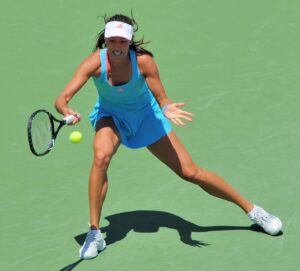We may earn money or products from the companies mentioned in this post.
Introduction to the Open Era in Tennis

Tennis, a sport known for its elegance and intensity, has evolved through various eras, each leaving its mark on the game’s history One of the most significant periods in tennis is the Open Era, which revolutionized the sport and brought about profound changes that continue to shape modern tennis today
Brief History of Tennis before the Open Era
Before diving into the significance of the Open Era, it is essential to understand how tennis operated before this groundbreaking period Prior to 1968, professional and amateur players competed separately, resulting in a fragmented and limited tennis landscape
Amateur players dominated the sport during this time They were not allowed to accept prize money and were expected to maintain their amateur status by not playing against professionals On the other hand, professional players were excluded from major tournaments like Wimbledon and faced financial challenges due to restricted opportunities for competition
The Significance of the Open Era in Modern Tennis
The Open Era, which began in 1968 with Grand Slam tournaments allowing both professional and amateur players to compete together, marked a turning point in tennis history This monumental change opened up new avenues for talent, increased competition levels, and elevated tennis into a global phenomenon
With professionals now able to participate alongside amateurs in major events like Wimbledon and Australian Open, barriers that once separated players based on their status vanished This inclusion led to an explosion of talent as previously unseen rivalries emerged between top-ranked players from different backgrounds
The introduction of prize money also transformed tennis into a viable career option for athletes As financial incentives increased, more talented individuals were encouraged to pursue tennis professionally rather than opting for other sports or careers
Transition from Amateur to Professional Tennis
The transition from amateur to professional tennis during the Open Era brought about significant changes in the sport’s culture and structure Players who were once considered amateurs had to adapt to a new era where they could compete for prize money, sign endorsement deals, and establish themselves as professionals
This shift not only affected players but also impacted the way tournaments were organized and managed Tennis associations and governing bodies had to navigate the challenges of managing a more complex sport with higher stakes and increased commercialization
Overall, the Open Era in tennis marked a pivotal moment that transformed the game into what we know today It broke down barriers, created new opportunities, and set the stage for breathtaking matches between some of the greatest athletes in history
Evolution and Impact of the Open Era on Tennis

Key Events that Led to the Beginning of the Open Era
The Open Era in tennis marked a significant shift in the sport’s landscape, bringing about equal opportunities and fair compensation for players This transformative period was catalyzed by key events that pushed for change
Firstly, there was mounting pressure from players who sought parity in terms of opportunities and financial rewards In the pre-Open Era, amateur players had distinct advantages over professionals when it came to participating in major tournaments The demand for a level playing field became increasingly vocal
Secondly, major tournaments began opening up to professionals, dismantling the traditional divide between amateurs and pros The move towards inclusivity gained momentum when prestigious events recognized that professional players possessed immense talent and deserved their place on the grand stage
Changes in Rules, Regulations, and Tournament Structures
The advent of the Open Era brought about a seismic shift in tennis rules, regulations, and tournament structures These changes were aimed at fostering a more competitive environment while providing greater opportunities for players
Gone were the restrictions on player eligibility based on amateur or professional status The introduction of open tournaments meant that all players could compete regardless of their background This not only leveled the playing field but also created an environment where talent could flourish without hindrance
Tournament formats also saw significant modifications during this period Grand Slam events expanded their draws to accommodate larger fields of competitors This allowed for more diverse representation across various skill levels and nationalities, creating thrilling matchups and enhancing global interest in tennis
The Role of Technology in Shaping Tennis during the Open Era
Technology played an instrumental role in shaping tennis throughout the Open Era, revolutionizing the way the sport was played, watched, and analyzed
Advancements in racket technology, such as the introduction of composite materials and innovative string designs, allowed players to generate more power and spin on their shots This led to a shift in playing styles and strategies, with players adapting to exploit these technological advancements to gain a competitive edge
Furthermore, technological innovations enhanced the spectator experience The introduction of Hawk-Eye technology brought precision to line calls, reducing controversial decisions and adding an element of certainty Television coverage also improved dramatically, with high-definition cameras capturing every nuance of the game and providing viewers with unparalleled access
In conclusion, the Open Era in tennis not only transformed the sport but also had a profound impact on its stakeholders From key events that paved the way for equal opportunities, to changes in rules and regulations that fostered inclusivity, and technological advancements that revolutionized gameplay and spectator experience – this era has left an indelible mark on tennis as we know it today
Famous players and iconic moments in Open Era Tennis

Top male and female players who dominated during different periods within the Open Era
In the realm of Open Era tennis, several remarkable players have left an indelible mark on the sport In the early years, Rod Laver emerged as a force to be reckoned with, capturing 11 Grand Slam titles and becoming the only player to achieve two calendar-year Grand Slams Billie Jean King was another dominant figure, advocating tirelessly for gender equality while amassing an impressive collection of 39 major titles
Bjorn Borg’s icy demeanor and relentless baseline game made him a legend in the late 1970s With his distinctive hairstyle and stoic presence, he clinched 11 Grand Slam championships On the women’s side, Chris Evert showcased her incredible consistency by winning a staggering 18 major titles throughout her career
As we moved into the next era of tennis, new stars emerged to captivate fans worldwide Pete Sampras’ powerful serve and impeccable volleying skills propelled him to greatness, securing a record-breaking 14 Grand Slam trophies Steffi Graf displayed grace and precision on every shot she executed, earning her an astonishing 22 major titles
The likes of Andre Agassi added flair and charisma to the game with his colorful outfits and aggressive playing style His versatility allowed him to claim eight Grand Slam victories during his illustrious career Meanwhile, Serena Williams burst onto the scene as one of the most dominant female athletes in history, amassing an incredible 23 major singles titles
Finally, in recent years, Roger Federer has enthralled audiences with his elegant shot-making abilities that seem almost effortless With an unprecedented record of 20 Grand Slam wins, he has established himself as one of tennis’ all-time greats Joining him in this era are Rafael Nadal, known for his relentless fighting spirit and clay court mastery, and Novak Djokovic, who possesses an unmatched mental fortitude and exceptional all-around skills
Memorable matches and rivalries that defined the sport’s landscape through this time
Within the Open Era, numerous matches have left tennis enthusiasts breathless with excitement One such encounter took place in 1980 at Wimbledon, where Borg and John McEnroe engaged in a captivating battle that lasted five sets The intensity of their rivalry was palpable as they showcased contrasting styles of play – Borg’s stoic baseline game against McEnroe’s fiery serve-and-volley tactics
The famous “Battle of the Sexes” match between Billie Jean King and Bobby Riggs also stands out as a significant moment in tennis history In 1973, King’s victory over Riggs not only shattered gender stereotypes but also highlighted the immense talent possessed by female players
In more recent years, the long-standing rivalry between Federer and Nadal has produced some of the most memorable matches ever witnessed Their epic encounters on multiple surfaces have captivated fans worldwide, showcasing skill, determination, and mutual respect
Another unforgettable rivalry is that between Serena Williams and her sister Venus Williams As two of the most dominant forces in women’s tennis, their clashes have been nothing short of electrifying Their battles on grand stages such as Wimbledon and the US Open have added another layer to their already inspiring family story
Open Era tennis has been blessed with incredible players who have etched their names into history while providing fans with countless iconic moments From Laver to Federer, King to Serena Williams – these athletes continue to inspire generations with their exceptional talent and unwavering dedication to the sport
Tournament Records

When it comes to the Open Era in tennis, there are some impressive tournament records that have been set over the years Let’s take a look at a few of them:
Grand Slam titles won by men’s singles players
The men’s singles category has witnessed some incredible performances in the Open Era Players like Roger Federer, Rafael Nadal, and Novak Djokovic have dominated the Grand Slam scene, accumulating numerous titles and leaving fans in awe of their talent
Grand Slam titles won by women’s singles players
The women’s singles category has also seen its fair share of remarkable achievements Icons such as Serena Williams, Steffi Graf, and Martina Navratilova have left an indelible mark on tennis history with their exceptional skills and ability to win prestigious Grand Slam titles
Records held by doubles teams
Doubles teams have displayed incredible teamwork and coordination on the court during the Open Era The Bryan brothers, Bob and Mike Bryan, hold an impressive record for winning the most doubles titles Their partnership is a testament to what can be achieved when two players combine their skills
Players Records

In addition to tournament records, individual players have made their mark in tennis history with some outstanding personal achievements:
Most career titles
Some players stand out for their consistent success throughout their careers Names like Jimmy Connors and Roger Federer top the list when it comes to capturing the most career titles Their dedication to the sport and relentless pursuit of excellence have earned them a special place in tennis lore
Consecutive weeks at world No:1 ranking
To be ranked number one in the world is a significant accomplishment in tennis Some players have held onto this coveted spot for extended periods, setting records that seem almost unbeatable The likes of Roger Federer, Novak Djokovic, and Serena Williams have spent many consecutive weeks at the top, showcasing their dominance over their competitors
Rising Stars: The future of tennis in the continuing Open era

As the Open Era continues to unfold, it is exciting to see new talent emerge and make their mark on the sport Young players like Coco Gauff, Bianca Andreescu, and Stefanos Tsitsipas are captivating audiences with their exceptional skills and hunger for success
These rising stars bring fresh energy and enthusiasm to the game as they challenge established champions Their performances on the court hint at a bright future for tennis as they strive to create new records and etch their names alongside the legends of the Open Era
The Legacy and Ongoing Significance of the Open Era in Tennis

Since its inception in 1968, the Open era has revolutionized the game of tennis, leaving an indelible mark on the sport This new era allowed both amateur and professional players to compete together for the first time, breaking down barriers and opening up a world of opportunities
An Era of Equality
One of the most significant legacies of the Open era is its emphasis on equality Prior to 1968, male and female players competed separately in their respective tournaments However, with the introduction of the Open era, men and women were given equal opportunities to showcase their talents on a level playing field
This shift in approach not only led to greater recognition and respect for female athletes but also paved the way for increased prize money parity between genders Today, we see top female tennis players earning just as much as their male counterparts – a testament to the progress made during this groundbreaking era
Rise of Superstars
The Open era also saw the emergence of numerous tennis superstars who captured hearts around the globe with their exceptional talent and captivating personalities Legends like Bjorn Borg, Martina Navratilova, John McEnroe, Steffi Graf, Roger Federer, Serena Williams, Rafael Nadal, and many others became household names during this period
These iconic players not only dominated their respective eras but also left an enduring impact on future generations Their incredible achievements continue to inspire aspiring young players worldwide to strive for greatness and push past boundaries
Evolutionary Changes
In addition to promoting equality and nurturing superstar talent, the Open era brought about various evolutionary changes that transformed how tennis is played today The introduction of new technologies such as composite rackets, advanced court surfaces, and improved training methods has revolutionized the game
Players now rely on power, agility, and strategy to outmaneuver their opponents The modern game is characterized by blistering serves, lightning-fast reflexes, and intense baseline battles that keep spectators on the edge of their seats
A Global Phenomenon
The Open era’s impact extended far beyond the tennis courts With increased media coverage and accessibility, tennis became a global phenomenon that captivated audiences worldwide Tournaments such as Wimbledon, the US Open, Roland Garros (French Open), and the Australian Open gained international recognition and attracted fans from all corners of the globe
Furthermore, the Open era facilitated greater cultural exchange as players from different nations competed against one another This diversity added richness to the sport and fostered a sense of unity among tennis enthusiasts worldwide
The Enduring Legacy

The legacy of the Open era in tennis is undeniable Its emphasis on equality, rise of superstar players, evolutionary changes to the game itself, and global reach have shaped tennis into what it is today – a thrilling sport that continues to captivate millions
As we look back at this transformative period in tennis history, it becomes clear that without the Open era’s groundbreaking changes and progressive mindset, we would not be witnessing such unprecedented levels of competition and excitement on both professional tours today
Useful Links

1968, Open era: The moment tennis opted to become a …
What does Open Era mean?
Tennis – ATP & WTA, Old vs New System
Why Are Tennis Tournaments Called Open?
TENNIS MONTH -May 2024
Tennis’ top grand slam winners of all-time: Who has won …
Tennis Before the Open Era – YouTube
Open Era | Podcast on Podbay
Who is the GOAT of Women’s Tennis?
Open Era Rankings
Top 10 Greatest Men’s Tennis Players of All Time
Reform to an Open status altered the course of tennis history
Solved 3.) The following table contains the ages of the 43
Open Era Bagel Bar: Owen talks to Devang Desai about …
The Open Era Review
Hear what #BreakTheBias means to sports icon and all …
Stat of the Day: Novak Djokovic becomes first man in Open …
Everything you need to know about the US Open
Has Novak Djokovic won the most Grand Slams? Has he …
Remembering The Start Of Open Tennis… 50 Years On






